Lower Walsall Street Works
|
Beginnings
In 1824 the site was occupied by the
northern half of the Shrubbery Iron Works that were founded
by George Benjamin Thorneycroft and his brother Edward. The
company became very successful, but began to run at a loss
due to the recession in the 1870s. The company closed in
December 1877, the closure being blamed on the higher wages
that were paid to the workforce. The northern half of the
works are marked as disused on the 1888 Ordnance Survey map,
and appear to have remained in a derelict state for many
years. |
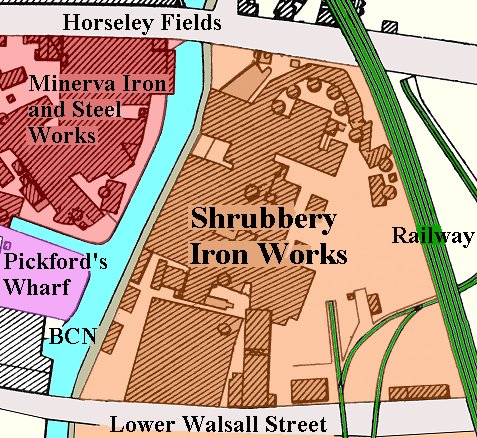
The site at the beginning of the 20th century when
the Shrubbery works were derelict.
In 1905 the Star Cycle Company began to produce a
low-cost range of cars, initially under the ‘Starling’ name,
adding a ‘Stuart’ model a year later. Star already produced
high quality, expensive cars which were manufactured by the
Star Engineering Company. In 1909 this company took over its
parent company (The Star Cycle Company) and the manufacture
of ‘Starling’ and ‘Stuart’ cars ceased. They were replaced
by the Briton Car Company under the direction of Edward
Lisle Junior, the son of Star's founder.
Briton started life in the company’s Stewart Street Works
where the ‘Starling’ and ‘Stuart’ cars had been built. The
same workforce were employed, and the first model, the 10hp.
‘Little Briton’ soon appeared.
In 1912 the company purchased the six acres of land between
Lower Walsall Street and Horseley Fields that were
previously occupied by the northern half of Shrubbery Iron
Works, and built a new factory on the site. |
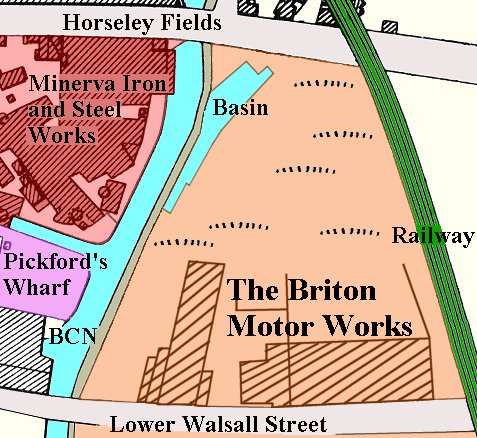
The works as originally built.
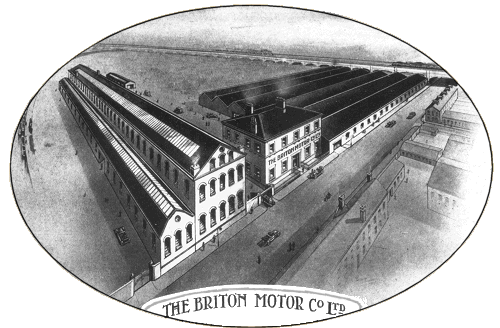
Lower Walsall Street Works in 1915.
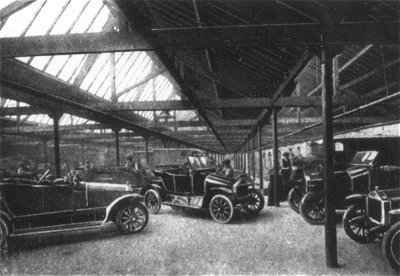
Briton Cars - final assembly shop.
| After the First World War the larger car manufacturers
had adopted mass production techniques, and the price of
their products fell. Briton could not compete in this new
market, and in 1921 production fell to just 65 cars. In
December of that year the company ended-up in the hands of a
receiver, and in January 1922 a liquidator was appointed. On
3rd October the works were sold to A. J. Stevens & Company
(1914) Limited and a new chapter began. |
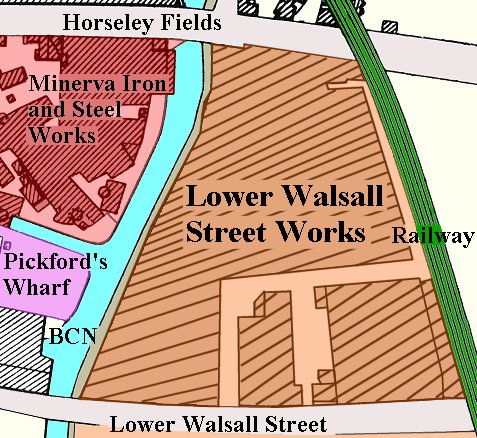
The A.J.S. factory.
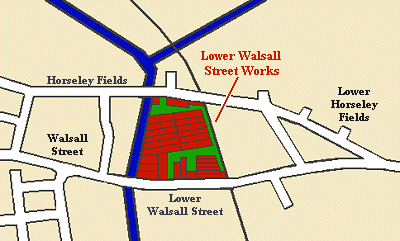
The location of the works.
| A.J.S. sidecars were selling extremely well and the
sidecar works at Stewart Street couldn't keep up with the demand. The
company decided that it had to increase production, and as there was no
more space available at Stewart Street for expansion, a new premises was
essential. In 1922 the Briton Car Company, who coincidentally used
to occupy the Stewart Street works before A.J.S. went into voluntary
liquidation. Their Lower Walsall Street works was put up for sale, and
Page & Sons, Estate Agents, sold the Walsall Street factory to A.J.S on October
3rd 1922 for £7,000. Before the end of 1922 the sidecar business moved
to Lower Walsall Street and by the end of 1924 the factory
had been expanded to over 150,000 sq ft. |
|

A plan of the works. |
A
B
C
D
E
F
G
H
I
J
K
L
M
N
O
P
Q
R
S
T
U
V
W
X
Y
Z |
Transformer Station
Wireless Polishing Shop
Boiler House
Works Entrance
Despatch Dept.
Varnish Shop
Paint Shop
Finishing Dept.
Offices
Hood & Trimming Dept.
Machine Shop
Caning & Panelling Dept.
Tool Room
Stores
Body Shop
Stores
Stores etc. under viaduct
Jig Stores
Saw Mill
Timber Store
Despatch Dept.
Offices
Press, Bobbing Shop
Frames & Welding
Erecting Shop
Enamelling Shop |
|
|
|
In 1923 A.J.S. began to produce wireless
receivers in the works to cater for the new market, made possible by the formation of the BBC. The
BBC was formed in 1922 and started regular broadcasts before the
end of the year.
By 1924 the workforce totalled 1,300 and the
future looked bright. In 1925 the wireless department expanded,
using Stewart Street Works for cabinet building. During the
next 2 years however, sales declined in both sidecars and
radios. In 1927 things looked brighter when A.J.S. got a contract to build car bodies
for the Clyno
'Nine' light car. The company also decided to build a commercial
vehicle chassis at Lower Walsall Street, and so the now
ailing wireless department moved from Lower Walsall Street
to Stewart Street to make room at the works for car body
building and commercial vehicle chassis production.
In February 1929 A.J.S. lost its lucrative
contract for Clyno car bodies, when Clyno went into
liquidation. At the same time the first commercial vehicle
chassis was launched. |
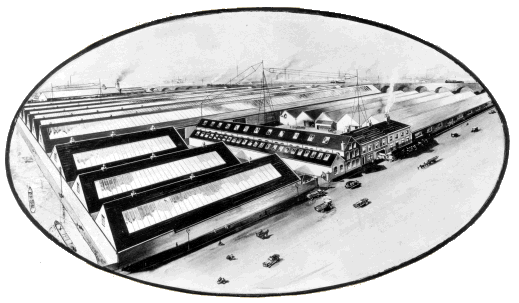
Lower Walsall Street Works.
|
Sales were still falling and A.J.S. decided to offset
the loss of the Clyno contract by building its own car called the A.J.S.
'Nine'. The bodywork was made at Lower Walsall Street and the cars were
assembled at Graiseley Hill.
Things got worse and the company went into
voluntary liquidation on 2nd October 1931. The works were
put up for sale and sold to Ever Ready Limited on 25th January 1932 for £12,750.
Charles Weight purchased some £40,000 worth of A.J.S. commercial vehicle
spares for £250 and moved them to his works at Chillington Fields. Sales
far exceeded the cost and what few items were left (mostly rear axles)
were scrapped in 1939 to assist the Government with their call for scrap
metal for the war effort.
Under Ever Ready the factory became known as Canal Works.
Every Ready produced items that were battery-powered and
would enhance the sale of their batteries. They manufactured
torches and portable lamps. The company also had a factory
in Park Lane where they made batteries and portable radios.
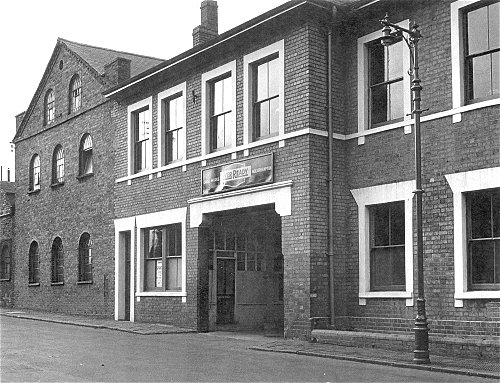
The Ever Ready works.
Ever Ready's Lower Walsall Street factory
closed in the early 1990s. The company went into liquidation
in 1998 and reformed under the name of Energizer. Since Ever Ready's departure, the factory became a
small industrial estate and was occupied by a number of
different companies including BRM Packaging Limited, Van
Smart vehicle conversions, and 24/7 spares and salvage.
Sadly the factory was destroyed by a huge fire which started on the
evening of the 5th December, 2022. After the fire, only a few buildings
directly alongside Lower Walsall Street remained. |
The following section is a
pictorial tour of the works in six parts. It contains a large number of
photographs and so may be slow to download.
The works photos are from the collection of the late Geoff Stevens,
who kindly allowed us to use them.
 |
Return to the
previous page |
|

